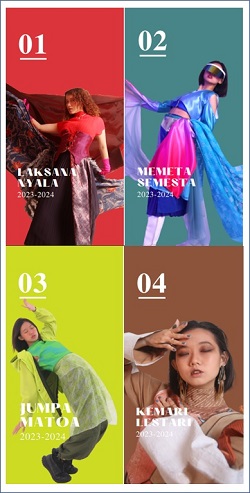it is said that there is no place that displays clothing as a person's status.As a result of this, the function of clothing which previously symbolized the image, prestige and status of the majority changed to only as a complement to the human body which is used for reasons of comfort or health in carrying out daily activities.
However, this can change again if activities return to normal. The data released for the years 2019-2020 shows that as one of the top 5 countries with the largest population in the world, only Indonesia is not included in the ranks of the world's cotton producers. Even though we know that cotton is one of the main commodities that are widely used in the world textile and clothing industry.
Not only that, the need for other raw materials is also imported from other countries because the number of local producers for this raw material is minimal. The consequence of this is clear, the large textile industry inevitably has to import from other countries.
In fact, it is rarely used to make synthetic materials or those made from animal materials, such as silk and wool. In fact, there is clearly great potential with a land area that is in the top 15 of the world.
As taught since childhood, clothing is a basic human need besides food and shelter.
If this measure is seen by state-owned enterprises (BUMN) engaged in this field, the Nusantara Clothing Industry Persero is not even among the top national SOEs and is not yet one of the SOEs listed on the Indonesia Stock Exchange (IDX). The upstream industry in the BUMN sector has yet to show its potential.
As an indicator of sectoral growth, private companies engaged in the textile and clothing industry are doing better with 21 companies listed on the IDX, but of all these companies it turns out that there are still those that do not use digital instruments optimally in the midst of this post-global pandemic.
You can imagine the general governance of this sector for companies that are not listed on the IDX.
As one of the sectors that has the potential to generate many jobs, of course this sector is worthy of consideration for the public and private sectors to be developed in the future for both the upstream and downstream industries.
Of course, business challenges will remain amidst increasingly intense global competition. We are certainly proud if this sector can be one of the sectors to be proud of at the global level.
Sri Prakash Lohia is one of the 15 richest people in Indonesia who is engaged in this sector.
This means that if managed properly, this sector can generate profits that are not inferior to other sectors. Moreover, this sector is also being developed intensively by the developed countries of the world, such as cotton from the United States, silk from China and wool from Australia.
The potential in that direction is clear, especially now that there are many local brands in the downstream sector that are starting to look at the world such as The Executive owned by PT Delamibrands Kharisma Busana, Eiger owned by PT Eigerindo Multi Produk Industri and Damn I Love Indonesia owned by PT Dinamika Anak Muda Nasional.
There are also several fashion models from Indonesia who are also known by the international fashion world, such as Tracy Trinita, Ayu Gani and Nadya Hutagalung.






